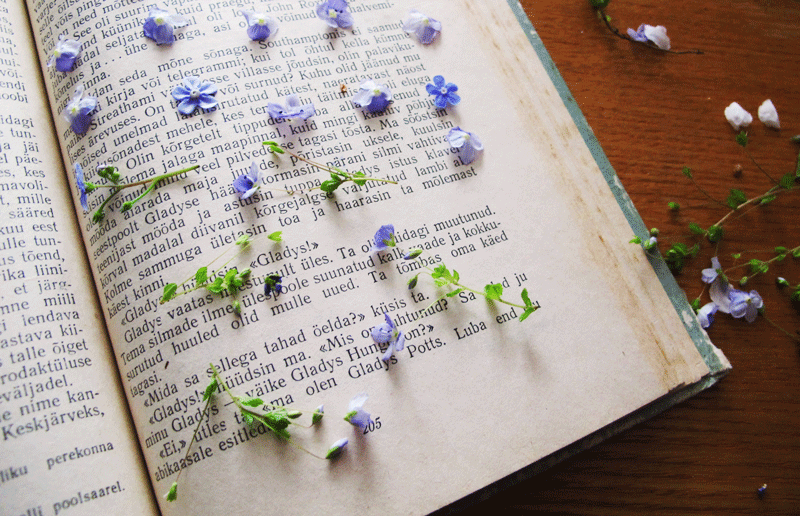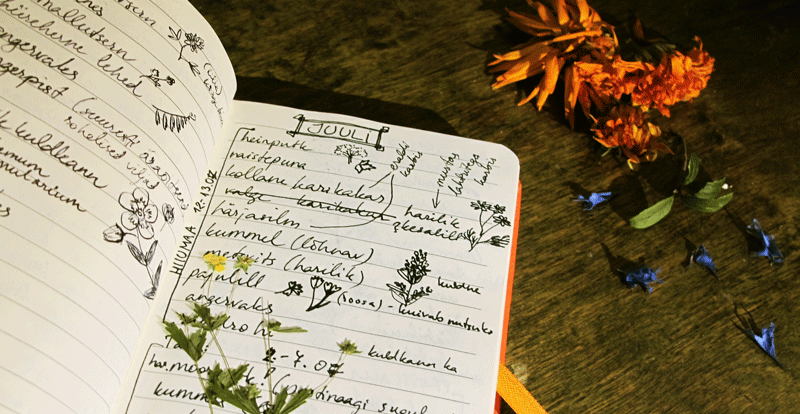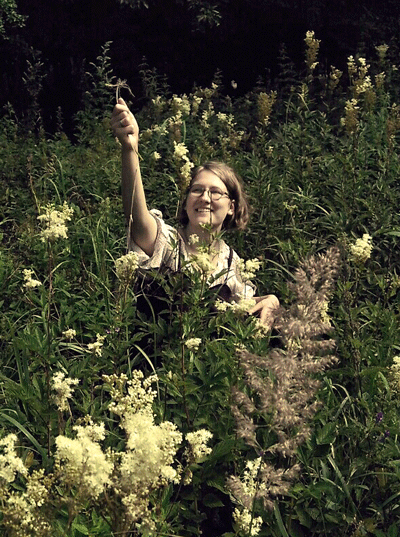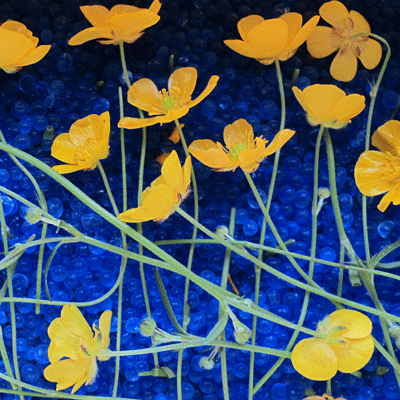EA Johnson is in town, meeting with Labora’s makers.
You can see what else he has been up to at flatfish.ee.
Enjoy his interview with Vaikelu’s creators Mirjam Parve and Ragne Schults.
Forget about drying the fragile flowers you’ve gathered by pressing them between the pages of a favourite book. Forget about those flowers because you probably will – although there’s always a chance you might happen across them years later only to discover several half-remembered passages stained by faded floral relics. Forget about those dried-out meadow or forest flowers because there are better ways to remember the glory that is spring even during the darkest days of winter.
If you happen to be in Tallinn’s Old Town, make your way to the beautiful Labora shop on Vene Street. There, among the sheets of handmade paper – many with floral inclusions veiled behind thin webs of fibre, you can pause to marvel at the alchemy that went into each one of Vaikelu’s miniature masterpieces.
While the French refer to a still life with the rather gruesome words nature morte (dead nature), Vaikelu’s crystalline microcosms might be better described as nature vivant (living nature). These floral compositions appear to have been frozen in time just for a second as they await their return to life. Like primeval plants trapped in clear transparent amber, Vaikelu’s creations seem to float in a kind of suspended animation.
Mirjam Parve and Ragne Schults, the two talented Tartu alchemists behind Vaikelu – an Estonian compound word which falls somewhere between a still life and a quiet one – would describe their creations with the Latin words herbarium or memento vivere – an attempt to turn the traditional notion of a memento mori inside out. Perhaps these miniature ikebana are more like moments – that very moment that passes between life and death.
While today these woman-made gems can be worn as a show of faith in the power of nature and in the belief of spring’s eternal return, there might have been an earlier time when they would have served as appropriate offerings to Demeter, the Corn Mother, to help her call her daughter Persephone back from the underworld. Or, reaching right back to the very cradle of civilisation, they might have served as gifts to Ningishzida, Mesopotamia’s gender fluid god-dess of both vegetation and the underworld – known as the Lord-Lady of the Good Tree – or perhaps even the Father-Mother of the All Preserving Sap.
So make way, Mary Shelley, for here come Vaikelu’s latest creations! Each encapsulated resin jewel resonates with both meaning and potential – and each one of them has their own unique tale to tell.
So it seems that the two of you met at Tartu, studying semiotics. How then should we interpret the floral signs contained within your jewellery? How did you go about using plants to create your own language of natural symbols?
What a terrifying set of questions! Although it was indeed semiotics that brought us together, our journey since graduation first had us narrowing our semiotically expansive approach to language into something more defined and operative, as we went on to study the dubious art of translation, and our endeavours to encapsulate plant matter have removed us from the world of conceptualisations further still. So, for us, the main draw of working with nature was in fact the respite it offered from a persistent compulsion to interpret everything, ceaselessly masticate meanings. And in that regard, we’d like to think that, drawing on our primal capacity to connect with nature, the flowers, mosses, lichen and mushrooms we preserve can be appreciated directly and viscerally. But, drawing on our modern capacity to over-complicate things, one must allow that it isn’t really that simple.
We started this venture with the lofty assumption that we were more in tune with nature and more knowledgeable of its leafy inhabitants than most of our peers. Having said that, it took us embarrassingly little time to come up against the magnificent massifs of our ignorance. Treating the different species as a homogenous whole was quite out of the question. And so began the how-do-you-dos and who-on-earth-are-yous – but once one has taken the time to identify a plant, one can’t really help but be curious, get to know them a little better, and, time permitting, delve into their lore. This is the stage where connections are made and relationships formed, the symbolic layer woven into flashy capes to adorn the favourites. For one can’t help but change one’s perception of a plant when one uncovers its odd and wonderful names and peculiar historical uses.
The importance of this personal connection can be felt very strongly whenever we put up our stall at fairs and have people approach us with their very own attachments, asking after the specific flowers they hold dear. This is why we try to work with a wide variety of plants – so that everyone gets to chance upon an old friend, and, failing that, make some charming new acquaintances.
At one point we read a fair bit about floriography, the language of flowers, thinking we might somehow incorporate it into our work, but we eventually deemed the whole thing far too undemocratic, as it was markedly unfair to the flowers that weren’t portrayed in a favourable light and to those that were not popular enough to be used as symbols at all. This subject of plant and
prejudice has come up surprisingly often, seeing as we thought it worthwhile to try and highlight the beauty of flowers that people tend to think of as unremarkable or of little value (and which therefore tend to come with names that range from the somewhat prosaic to the downright unpalatable). It is also for the sake of fairness, that we’ve decided to not place the herbariums on a bed of lore, as the wordy extras might muddle the mind and sway the senses of those not very familiar with the plant kingdom. This said, we are fully aware that some of our patrons like to wear the herbariums as talismans and tend to take a more herbalist approach when deciding on the right piece, but although this is significantly less arbitrary than floriography, we still wouldn’t feel comfortable employing it in our marketing pursuits (“Oh don’t you look exhausted, Madam! Maybe you should have a look at our rather lovely brooch with valerian? One lick for peace of mind, two for a good night’s sleep!”).
Having made a conscious effort to be impartial and just, we hope for leniency for the moments when the semiotic urges prove too strong to suppress – as such, we admit to occasional orchestrations of significant colours (e.g. we’ve made heather, bishop’s weed and red-stemmed feathermoss stand for the suffragette colours of violet, white and green), and to having walked the Frankensteinian walk – adorning ferns with blossoms, blossoms with mossy appendages, manipulating petals, leaves and stems into maximalist pieces of make-believe.
In a word, there is really no escaping language, but, as a rule, we try to frame the plants in a way that would allow them to speak for themselves.
While Tartu University may not be ancient enough for its early scholars to have dabbled in alchemy, it seems that the two of you have had to become alchemists in order to master your creations. Without divulging any of the secrets behind your magical resin, how much trial and error went into creating your floral creatures, your babies? Strangely, baby is the word which the ever-quirky Google Translate uses to capture Vaikelu in English.
Although we would dearly love to uphold the hitherto unappreciated tradition of our esteemed alma mater and have nothing to do with alchemy at all, the comparison, in some ways, feels astoundingly apt. There is the number of failed experiments, for one. And the fact that work with the combined media of plant matter, resin and silicone involves a high degree of unpredictability. Perseverance and obsessiveness also rings true – however bad the failings, the promise of success was enticing enough to not give up.
We started experimenting with resin more than three years ago, the first six or seven months saw a string of botched attempts at something or other and a novel approach to problem-solving that mainly consisted of creating a more expansive set of problems to tackle. Every so often there were a few pieces that came out better than expected, not many, but just enough to keep us hooked. And tinkering with a new medium is always exciting – discovering its potentials and pushing at its limits. We found that some plants react with resin in unexpected ways, that there are those that are sensitive to shifts in temperature, to paints and sealants. We also tried a range of different resins and means of pre- and post-cure manipulation, ascertained the best way to go about things and finally found the ecologically sourced variant we use today.
And then there were the plants to consider. Although resin can be temperamental and the crafting process time-consuming, one of the greatest challenges was drying the flowers in a way that would alter them as little as possible. Thus began a series of experiments that have continued to this day, for we’ve discovered that the best drying method depends on the water content of the plant and every species needs to be approached individually.
So, once we were comfortable with resin and reasonably happy with our technique of drying and preserving the plants, we had to rein in the creativity and focus on fine-tuning the particular designs, once that was done, the real work could begin. And this has shaped our last few years – we pick plants from April to October and craft the pieces from April to December, the rest of the year is spent on cultural pursuits and product development. We’ve learnt to guide the crafting process somewhat and have considerably reduced the number of pieces that commit scrapable offences, but it is still an uphill battle against nature’s entropic tendencies. Just as it should be.
And speaking of laboratories, assuming that you’ve visited the Labora workshops on Laboratooriumi Street in Tallinn’s Old Town, please describe your impressions as well as any interesting connections you may have noticed there with your own creative work.
We’ve yet to visit the famous workshops, but have heard that it is a magical place and hope to visit someday soon.
You can read more about Mirjam, Ragne, and their babies on their website. And you can find their latest creations searching for adopted homes at the Labora Shop located on Vene 18, Tallinn.
All photos were kindly provided by Vaikelu.









